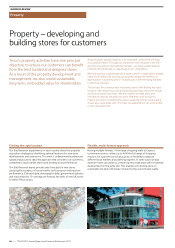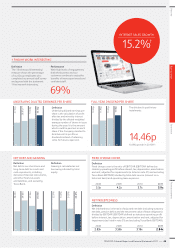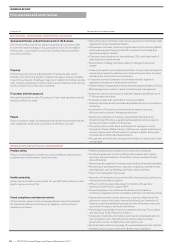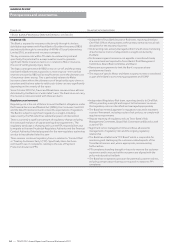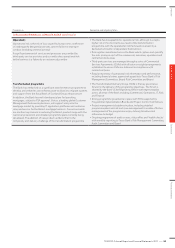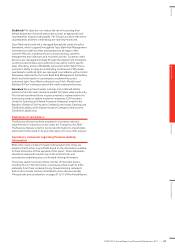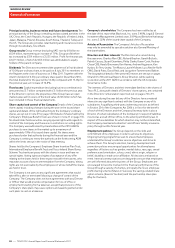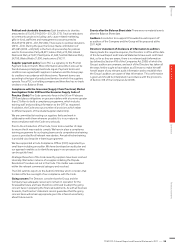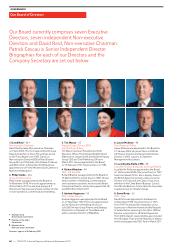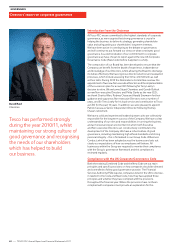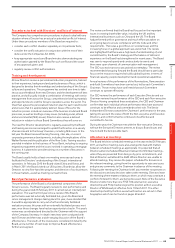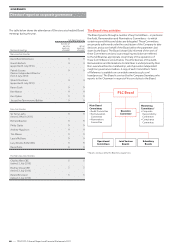Tesco 2011 Annual Report Download - page 60
Download and view the complete annual report
Please find page 60 of the 2011 Tesco annual report below. You can navigate through the pages in the report by either clicking on the pages listed below, or by using the keyword search tool below to find specific information within the annual report.
56
—
TESCO PLC Annual Report and Financial Statements 2011
BUSINESS REVIEW
Principal risks and uncertainties
Some of the larger UK banks have significant funding targets for 2011
and, coupled with the expiry of the Special Liquidity Scheme, will
increase the possibility of aggressive competition in both the retail and
wholesale funding markets. This increase in demand could increase the
cost of both retail and wholesale funding although improving market
sentiment in the wholesale funding markets may generate additional
supply. It is intended that the majority of the Bank’s funding will
continue to be raised in the retail deposit market with a product range
and competitive deposit rates designed to attract a wider customer
base. The Bank also accesses the wholesale funding markets, having
successfully completed a £125 million Wholesale Bond from the Bank’s
Euro Medium Term Note programme which provides an additional
source of funding from retail investors.
Interest rate risk management Our objective is to limit our profit
and loss downside from rising interest rates. Forward rate agreements,
interest rate swaps, caps and floors are used to achieve the desired mix
of fixed and floating rate debt.
Our policy is to fix interest rates for the year on a minimum of 40% of
actual and projected debt interest costs of the Group excluding Tesco
Bank. At the year end, £6.2 billion of debt (2010 – £5.6 billion) was at
fixed rates of interest. This equates to 91% of total debt (2010 – 72%).
The remaining balance of our debt is in floating rate form. The average
rate of interest paid on an historic cost basis this year, excluding joint
ventures and associates, was 5.4% (2010 – 5.4%).
Interest rate risk arises where assets and liabilities in Tesco Bank’s
banking activities have different repricing dates. Tesco Bank policy
seeks to minimise the sensitivity of net interest income to changes in
interest rates. Potential exposures to interest rate movements in the
medium to long term are measured and controlled through position
and sensitivity limits. Short-term exposures are measured and
controlled in terms of net interest income sensitivity over 12 months
to a 1% parallel movement in interest rates. Tesco Bank also uses Value
at Risk (VaR) for risk management purposes with a time horizon of one
trading day and a confidence interval of 95%. Interest rate risk is
managed using interest rate swaps as the main hedging instrument.
Foreign currency risk management Our principal objective is to
reduce the effect of exchange rate volatility on operating margins.
Transactional currency exposures that could significantly impact
the Group Income Statement are managed, typically using forward
purchases or sales of foreign currencies and currency options. At the
year end, forward foreign currency transactions, designated as cash
flow hedges, equivalent to £1.615 billion were outstanding (2010 –
£1.083 billion) as detailed in note 22. We do not actively hedge our
investment in our international subsidiaries other than by ensuring that
each subsidiary is appropriately leveraged. During the year, currency
movements decreased the net value of the Group’s overseas assets by
£241 million (last year increase of £477 million). We translate overseas
profits at average foreign exchange rates which we do not currently
further manage.
Financial review
The main financial risks faced by the Group relate to the availability
of funds to meet business needs, fluctuations in interest and foreign
exchange rates and credit risks relating to the risk of default by
counterparties to financial transactions. The management of these
risks is set out below. The Group Balance Sheet position at 26 February
2011 is representative of the position throughout the year.
Funding and liquidity The Group finances its operations by a
combination of retained profits, disposals of property assets, long
and medium-term debt capital market issues, short-term commercial
paper, bank borrowings and leases. The objective is to ensure continuity
of funding. The policy is to smooth the debt maturity profile, to arrange
funding ahead of requirements and to maintain sufficient undrawn
committed bank facilities and a strong credit rating so that maturing
debt may be refinanced as it falls due. Tesco Group has a long-term
rating of A3 with a negative outlook by Moody’s, A- (stable) with Fitch
and A- (stable) by Standard & Poor’s. New funding of £1.7 billion was
arranged during the year, including a net £1.6 billion from property
disposals and £0.1 billion from long-term debt. At the year end, net
debt was £6.8 billion (2010 – £7.9 billion).
Liquidity and funding has been a key area of focus in the banking
industry and for financial services regulators. The FSA’s new liquidity
framework became effective on 1 June 2010 with Tesco Bank subject
to additional liquidity requirements in the form of Individual Liquidity
Guidance (ILG).
Tesco Bank maintains a robust and prudent liquidity risk management
approach with an effective governance structure for measuring,
managing and monitoring liquidity, as defined in its Liquidity Risk
Management Policy, which provides the framework which enables
funding and liquidity to be maintained in excess of regulatory
requirements. The Bank has built up a strong liquidity position with
a diversified stock of highly marketable liquid assets that can be used
as a buffer against unforeseen impacts on cash flow or in stressed
environments. Stress testing is regularly undertaken to simulate
how events may impact its funding and liquidity capabilities and is
updated where required as market conditions evolve. The Bank’s first
Internal Liquidity Adequacy Assessment (ILAA) was submitted to the
FSA during the year with external assurance provided in relation to
this report.


